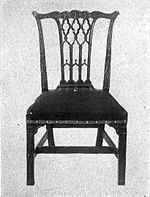Thomas Chippendale

Thomas Chippendale (baptised 16 June [O.S. 5 June] 1718 - November 1779) [1] was a London cabinet-maker and furniture designer in the mid-Georgian, English Rococo, and Neoclassical styles. He went to London in 1749 where, in 1754, he became the first cabinet-maker to publish a book of his designs, titled The Gentleman and Cabinet Maker's Director. Three editions were published, the first in 1754, followed by a virtual reprint in 1755, and finally a revised and enlarged edition in 1762, by which time Chippendale's illustrated designs began to show signs of Neoclassicism.
Chippendale was much more than just a cabinet maker, he was an interior designer who advised on soft furnishings and even the colour a room should be painted. He worked in partnership initially with the upholsterer James Rannie and later with Rannie's assistant, Thomas Haig, but artistic control of the luxurious furnishings that came from his premises in St. Martin's Lane was firmly in Chippendale's hands.

In 1978, Christopher Gilbert was able to identify from among over sixty known clients twenty-six documented commissions where surviving furniture by Chippendale could be identified, much of it still in the aristocratic houses for which it was made. Chippendale furniture was supplied to Blair Castle, Perthshire, for the Duke of Atholl (1758); Wilton House, for Henry, 10th Earl of Pembroke (c 1759-1773); Nostell Priory, Yorkshire, for Sir Roland Winn, Bt (1766-85); Mersham Le Hatch, Kent, for Sir Edward Knatchbull, Bt (1767-79); furnishings for the royal family and for the actor David Garrick both in town and at his villa at Hampton, Middlesex; Normanton Park, Rutland and other houses for Sir Gilbert Heathcote Bt (1768-78) that included the management of a funeral for Lady Bridget Heathcote, 1772; Harewood House, Yorkshire, for Edwin Lascelles (1767-78); Newby Hall, Yorkshire, for William Weddell (c 1772-76); Temple Newsam, Yorkshire, for Lord Irwin (1774); Paxton House, Berwickshire, Scotland, for Ninian Home (1774-91); Burton Constable Hall, Yorkshire for William Constable (1768-79); Petworth House, Sussex and other houses for George Wyndham, 3rd Earl of Egremont (1777-79), to name only the most outstanding commissions.
He collaborated in furnishing interiors designed by Robert Adam and at Brocket Hall, Hertfordshire, and Melbourne House, London, for Lord Melbourne, with Sir William Chambers (c. 1772-75).

His workshop was continued by his son, Thomas Chippendale, the younger (1749-1822), who worked in the later Neoclassical and Regency styles, "the rather slick delicacy of Adam's final phase", as Christopher Gilbert assessed it.[2] A bankruptcy and sale of remaining stock in the St. Martin's Lane premises in 1804 did not conclude the firm's latest phase, as the younger Chippendale supplied furniture to Sir Richard Colt Hoare at Stourhead until 1820 (Edwards and Jourdain 1955: 88).
Recognizably "Chippendale" furniture was produced in Dublin and Philadelphia, as might be expected, but also in Lisbon, Copenhagen, and Hamburg. Catherine the Great and Louis XVI both possessed copies of the Director in its French edition. (Gilbert 1978, xvii). As a folk hero of English craftsmanship, he is enshrined as a full-size sculpted figure standing among other notables adorning the facade of the Victoria and Albert Museum, London.

His designs became very popular again during the middle to late 19th century, leading to widespread adoption of his name in revivals of his style, so much so that dealers spoke of "Chinese Chippendale", "Gothic Chippendale", and even "Irish Chippendale". Many of these later designs that attach his name bear little relationship to his original concepts.
The "Chinese Chippendale" chair is characterized with having a pagoda roofline, dragon motifs, and flipped up ears on the top. The body of the chair has fretwork, a stretcher for carving, a drop in seat with an exposed wooden apron. Its legs are sober in the back and square in section, on block feet. The "Gothick Chippendale" chair has a cupid's bow crest rail, highly pierced splat, and a stretcher that is for show rather than function. The chair also has a completely covered seat as opposed to the drop in seat. The legs are straight or square but do not sit on feet. This chair has a masculine and rectilinear quality. The "Neo-classical Chippendale" chair is a lyre back chair. The integrated crest rail at the top has flipped up ears. There is a boss, or circular decorated motif, often incorporated into the design of this chair. The central splat is in the shape of a lyre. Greek and Roman motifs are often also incorporated into the chair. This chair differs from the Gothick Chippendale by having a drop in seat. It is similar to the Chinese Chippendale by having an exposed apron.
There is a statue and memorial plaque dedicated to Chippendale outside the old Prince Henry's Grammar School in Manor Square, in his home town of Otley, near Leeds, Yorkshire.
See also
Notes
- ^ "Thomas Son of John Chippindale of Otley joyner bap ye 5th" (Otley, Yorkshire Parish Register, June 1718). He was buried 16 November 1779, according to the records of St Martin's-in-the-Fields, in the burying ground now occupied by the National Gallery. Details of Chippendale's life are drawn from Christopher Gilbert, The Life and Works of Thomas Chippendale (New York: Macmillan) 1978, "Biographical Essay".
- ^ Gilbert 1978:I,122.
External links
- The Chippendale Society
- Gentleman and Cabinet Maker's Director, first edition, 1754 – online as part of the University of Wisconsin's Digital Library for the Decorative Arts and Material Culture.
- Ralph Edwards and Margaret Jourdain, 1955. Georgian Cabinet-Makers.
- Christopher Gilbert, 1978. The Life and Work of Thomas Chippendale 2 vols. (New York: Macmillan) 1978.. The standard work.
- Thomas Chippendale - The Legend!
